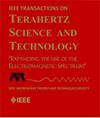用于未来太赫兹空间偏振计的超灵敏KIDs演示
IF 3.9
2区 工程技术
Q2 ENGINEERING, ELECTRICAL & ELECTRONIC
IEEE Transactions on Terahertz Science and Technology
Pub Date : 2025-03-01
DOI:10.1109/TTHZ.2025.3566218
引用次数: 0
摘要
本文对漏透镜-天线耦合微波动力学电感探测器(KIDs)在1.5太赫兹的偏振纯度进行了测量和模拟。从极化相位和振幅波束方向图测量中,我们发现1 f# $\lambda$空间采样的积分交叉极化比为-21.5 dB。测量结果与理论描述一致,理论描述是基于天线馈电的发射仿真和天线- kid系统的接收分析相结合的结果。中性密度滤波器将每个探测器的功率限制在500 fW左右,使这些测量能够在低背景下测量噪声等效功率为5-7 $\times 10^{-20}$ W $/\sqrt{\text{Hz}}$的探测器上进行。这些综合测量表明,这些探测器是大规模和高性能成像偏振仪器的优秀候选者。本文章由计算机程序翻译,如有差异,请以英文原文为准。
Demonstration of Ultrasensitive KIDs for Future THz Space Borne Polarimeters
We present measurements and simulations of the polarization purity of leaky lens-antenna coupled microwave kinetic inductance detectors (KIDs) at 1.5 THz. From polarized phase and amplitude beam pattern measurements we find the integrated cross-polarization ratio to be at –21.5 dB for 1 f#$\lambda$ $\times 10^{-20}$ $/\sqrt{\text{Hz}}$
求助全文
通过发布文献求助,成功后即可免费获取论文全文。
去求助
来源期刊

IEEE Transactions on Terahertz Science and Technology
ENGINEERING, ELECTRICAL & ELECTRONIC-OPTICS
CiteScore
7.10
自引率
9.40%
发文量
102
期刊介绍:
IEEE Transactions on Terahertz Science and Technology focuses on original research on Terahertz theory, techniques, and applications as they relate to components, devices, circuits, and systems involving the generation, transmission, and detection of Terahertz waves.
 求助内容:
求助内容: 应助结果提醒方式:
应助结果提醒方式:


